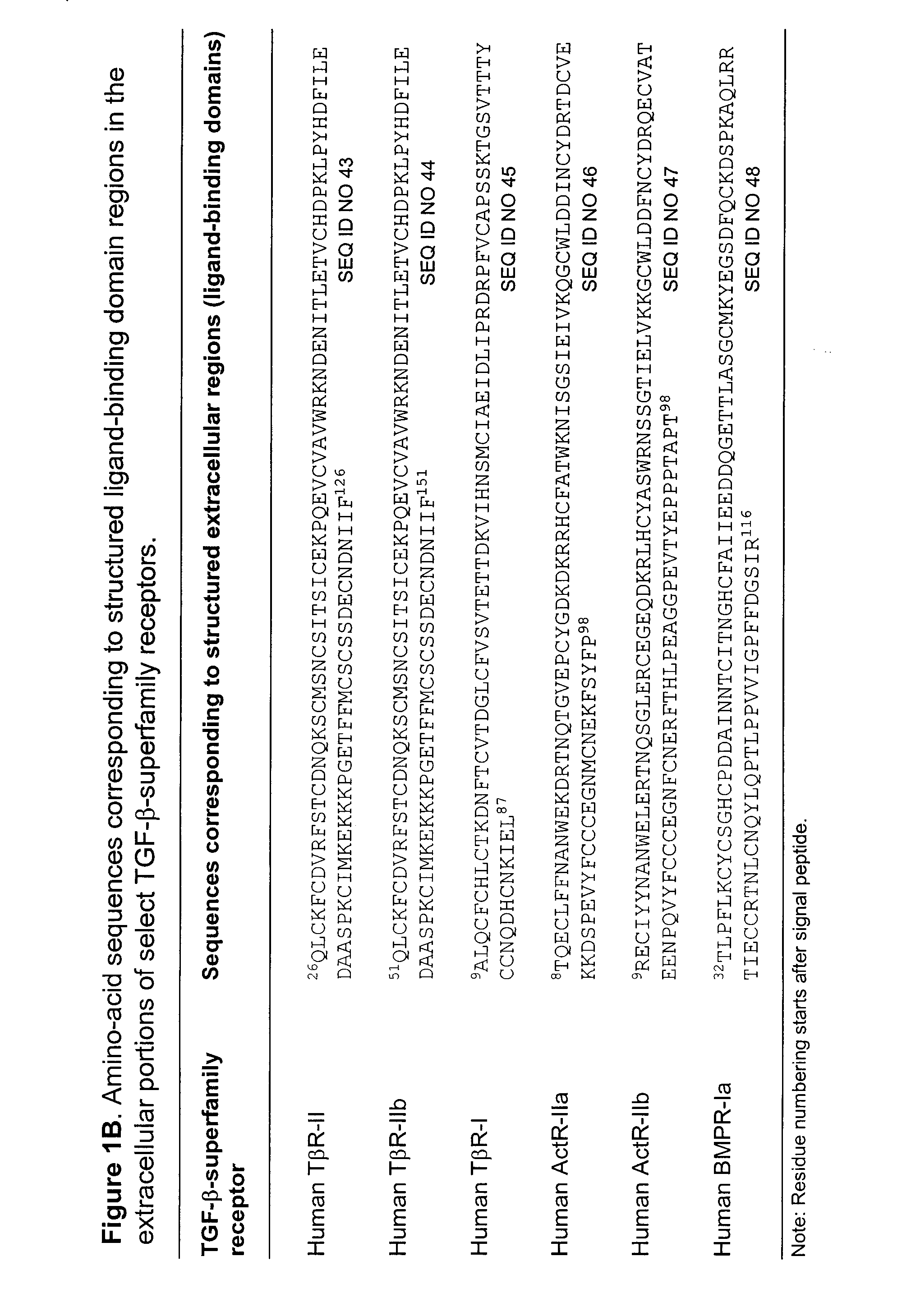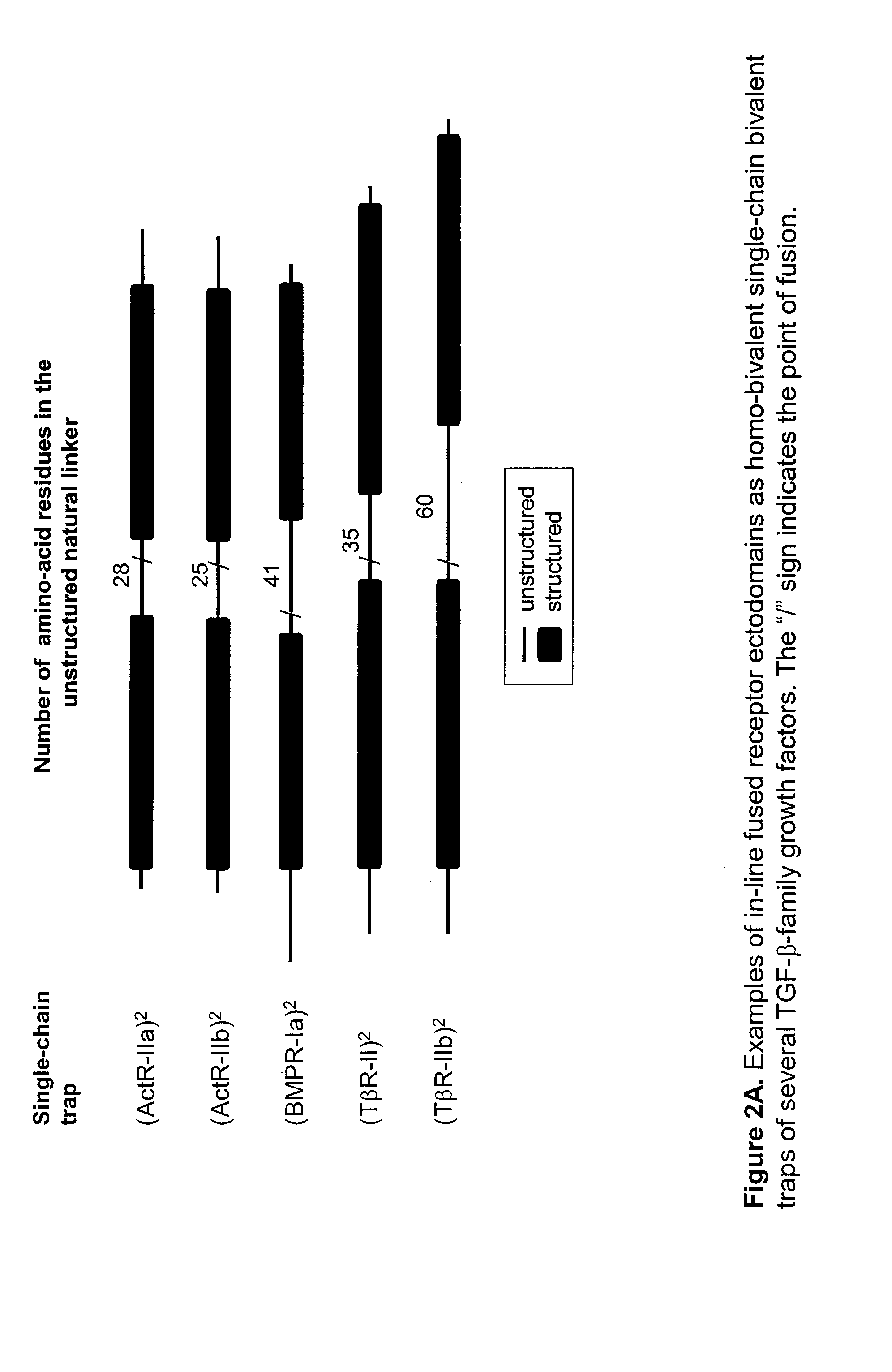Antagonist of ligands and uses thereof
a technology of ligands and antagonists, applied in the field of anti-agonists, can solve the problems of many undesirable biological processes, less than could be desired effect of monovalent trii to antagonize tgf-, and difficult to achieve the effect of reducing steric and electrostatic incompatibility and reducing molecular mechanics energy
- Summary
- Abstract
- Description
- Claims
- Application Information
AI Technical Summary
Benefits of technology
Problems solved by technology
Method used
Image
Examples
experiment # 1
[0115]Experiment #1: Design Strategy of Single-Chain Bivalent Traps for TGF-β-Family Ligands
[0116]1. Single-chain recombinant traps were designed against growth factors that belong to the transforming growth factor TGF-β superfamily of cysteine-knot cytokines according to SCOP (Andreeva et al., 2008, Nucl. Acid Res. 36: D419) and Pfam (Finn et al., 2006, Nucl Acid Res. 34: D247) structural classifications. More specifically, these growth factors including, for example, TGF-βs, activins and BMPs, share the same 3D architecture and form covalent disulfide-linked homodimers. The method disclosed herein is applicable to all members of the TGF-β superfamily, including TGF-β1, β2, -β3; activin βB, βC, βE; bone morphogenetic proteins (BMP) 2-15; growth differentiation factors (GDF) 1, 3, 8 (myostatin), 9 and 15; Nodal; Inhibin α; anti-Mullerian hormone (AMH); Lefty 1 and 2; Arteman, Persephin and Neurturin.
[0117]2. Single-chain recombinant traps against TGF-β superfamily growth-factors wer...
experiment # 2
[0120]Experiment #2: Feasibility Assessment Procedure for Designed Single-Chain Bivalent Traps
[0121]To the extent to which the structures of various TGF-β-superfamily growth factors are conserved, the structures of their cognate receptor ectodomains are conserved, and the 2:1 receptor-ligand binding stoichiometry is conserved, the concept of fusing two natural receptor ectodomain sequences to produce single-chain homo-bivalent traps with improved in vitro ligand binding affinity and cellular ligand neutralizing activity relative to respective monovalent receptor ectodomains, is applicable to the entire family of TGF-β family. The feasibility of these ligand traps can be theoretically assessed routinely by following the stepwise procedure outlined below. Although the procedure is presented for homo-bivalent single-chain traps, it also applies to other designs covered here, e.g., hetero-bivalent and hetero-tetravalent single-chain traps.
[0122]1. The linear distance is measured between...
experiment # 3
[0135]Experiment #3: Small Scale Production of Prototype (TβRII)2 and Demonstration of TGF-β-Binding Activity
[0136]FIG. 6 shows a schematic of prototype (TβRII)2. The prototype (TβRII)2 gene was cloned into mammalian expression vector pTT and increasing amounts were transiently transfected into HEK293 cells. The conditioned media from these transfected cells were collected after 5 days and tested via SPR Biacore analysis for the binding of secreted (TβRII)2 to a TGF-β3 surface (FIG. 7A). The sensogram shows increasing levels of binding that correlates with cells transfected with increasing levels of (TβRII)2 plasmid (ranging from 1% to 95% transfected cells), indicating a dosage effect and specific binding. The binding characteristics of (TβRII)2 (produced from 95%-transfected cells) was compared with dimerized TβRII-Fc and monomeric TβRII (FIG. 7B). The sensogram of prototype (TβRII)2 was similar to the TβRII-Fc interaction (slow off rate), and both were distinct from monomeric TβR...
PUM
| Property | Measurement | Unit |
|---|---|---|
| time- | aaaaa | aaaaa |
| time- | aaaaa | aaaaa |
| molecular mass | aaaaa | aaaaa |
Abstract
Description
Claims
Application Information
 Login to View More
Login to View More - R&D
- Intellectual Property
- Life Sciences
- Materials
- Tech Scout
- Unparalleled Data Quality
- Higher Quality Content
- 60% Fewer Hallucinations
Browse by: Latest US Patents, China's latest patents, Technical Efficacy Thesaurus, Application Domain, Technology Topic, Popular Technical Reports.
© 2025 PatSnap. All rights reserved.Legal|Privacy policy|Modern Slavery Act Transparency Statement|Sitemap|About US| Contact US: help@patsnap.com



